People
Mary Harvey
1746-1785
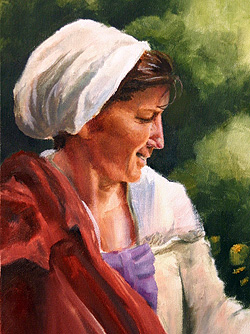
Mary Harvey
© 2008 Bryant White
Prologue
Mary Arms Harvey was the oldest surviving child of Daniel Arms, Jr., and Mary Stebbins. She was born on March 26, 1747, one of five children—one boy and four girls. She lived at the south end of town in the home her father's father had purchased in 1719. A drawing of her home dating from 1896 survives; it depicts a house that would have been considered quite respectable for the time, assuming the house in the drawing has not been altered.
As the oldest daughter, Mary doubtless had the responsibility of attending to her younger siblings, along with a female family member's usual duties of cooking, sewing, laundry, cleaning, dairying and attending to the kitchen garden. It is not known whether she received any education or was literate. It is likely that, as a female, she might have received the rudiments of an education that would have at included learning to read the printed word at the least, some Bible study, and perhaps some skill in writing. Except for visits to friends and relations, Mary would have lived at home until her marriage.
Mary's future husband, Simeon Harvey, was four years her elder. He lived in nearby Montague, where his father, Samuel, had settled. Like many other young Massachusetts men, Simeon served in the French and Indian, or Seven Years', War. Upon his return in 1761, he apprenticed to Deacon Jonathan Arms of Deerfield (Mary's father's cousin) to learn blacksmithing. Jonathan's blacksmith shop was in the center of Deerfield, a short walk from Mary's home. Mary might have met Simeon through social gatherings, family connections, or at the meetinghouse. They were wed on January 29, 1768. That same year, Simeon paid four pounds to Joseph Barnard "to Rent of House & Garden one year Ending April 1-1769".(1) In March their first child, Emilia, was born. Simeon bought a four-plus acre lot from Joseph Smead in 1770. Located just up the street from Mary's childhood home, the lot included a house & barn. Simeon also built a blacksmith shop on this lot.
From 1769 until her death in 1785, Mary gave birth every year or every other year. Her living children numbered nine, and she would die giving birth to her tenth child, who was stillborn.
Anxious Times
Times were not peaceful in New England during the first half of the 18th century. Certainly Mary knew of the French and Indian raid on Deerfield that had occurred in 1704 and probably heard first-hand accounts of it from her maternal grandfather, John Stebbins, who had been captured at the age of 19 and redeemed.
On Aug. 25, 1746, less than a year before Mary was born, a handful of Native Americans raided town residents who were working in farm fields in an area just south of town known as "The Bars." Three men and two children were killed and scalped; one child was wounded, and another was captured. Soon after, the tragedy would be memorialized in a poem by Lucy Terry Prince, a slave living in Deerfield at the time of the raid. Lucy and Mary lived a few doors apart, and it is not unlikely that Mary might have heard Lucy recite her poem.(2)
Although the town of Deerfield was not attacked during the French and Indian War that began in 1754, a number of residents did serve in the militia, including Mary's father and her future husband, Simeon Harvey. Similarly, Deerfield was not attacked during the Revolutionary War, but a number of residents served on both sides. Interestingly, Simeon Harvey was drafted, but chose to pay a fine rather than serve his time.
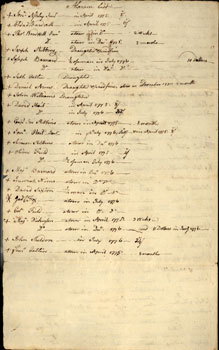
Mary's husband, Simeon, chose to pay a fine rather than serve in the town militia early in the American Revolution. His name does not appear on this "Alarm List." However, his family connections and his own participation on the Deerfield Committee of Safety suggest that he was not a Loyalist.
More info
Courtesy Pocumtuck Valley Memorial Association, Deerfield, MA
His reasons for refusing to serve are not known, but Simeon was not alone in making this decision. As in other communities, some Deerfield men, including some prominent patriots, chose at various points to pay fines or hire substitutes. Some claimed that it was simply not a good time to leave their farm and/or business for an extended period of time. In 1779, after the war moved south, Simeon would serve on Deerfield's Committee of Safety(3), suggesting that his loyalty to the American cause was not in doubt.
Mary thus had been exposed to war, albeit from a distance, all of her life. She knew of its tolls and its aftermath, its sorrows and anxieties. She had experienced the scarcity of goods and high prices that wars caused, and she knew how they strained family finances and challenged daily household functions. It is likely, then, that on the November day in 1783 when she stopped at John Williams' store, she was pleased to see a good variety of much-needed fabric for clothing at affordable prices. The Williams store day book entries for that month show that Mary purchased 4 different kinds of fabric amounting to just over 21 yards.
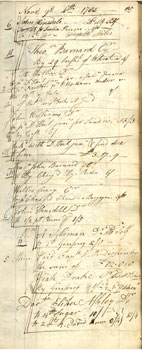
On November 11, Mary Harvey made several purchases at John Williams' Deerfield store, charging them to her husband Simeon's account.
More info
Courtesy Pocumtuck Valley Memorial Association, Deerfield, MA
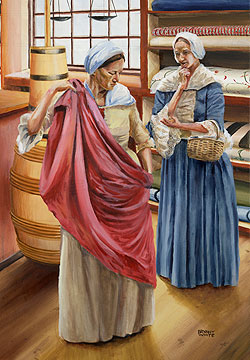
Like most women, Mary Harvey purchased the dozens of yards of fabric and finishing goods needed to clothe her large (and growing) family. Detail from Boom and Bust
© 2008 Bryant White
After enduring years of scarcity and high prices, Mary likely enjoyed perusing John Williams' well-stocked inventory of English fabric and other imported goods. Likewise, Simeon might have felt just as fortunate in 1784, when he, John Williams and Joseph Stebbins, were able to pay off in "Continental Bills of Credit" a sizeable debt of 10,150 pounds that they owed to Cornelius Jones of Hatfield.
News of the treaty ending the Revolutionary War in 1783 must have been a relief, but still Mary might have wondered how long peaceful conditions would last. She may have felt thankful that her only son was still too young to join in any fighting in the near future. She would experience for only a short period the severe recession that followed the initial economic activity and optimism of 1783. Mary Harvey died in childbirth on December 2, 1785, at the age of 38. She was buried with her stillborn infant in her arms.
Epilogue
Like most Deerfield residents, Mary's husband Simeon chose not to take up arms against the government during the Massachusetts Regulation. Shortly before Mary's death, Simeon did represent Deerfield at a county convention held in nearby Hatfield, after four other Deerfield men asked to be excused from this duty. The Hatfield Convention produced a series of resolutions criticizing the fiscal policies of the Massachusetts government and airing grievances.
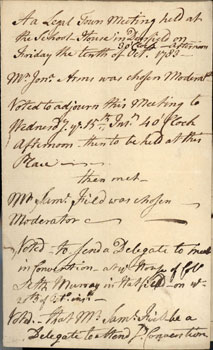
Mary's husband Simeon traveled to Colonel Seth Murray's house at Hatfield to meet with representatives from Hampshire County towns.
More info
Courtesy Pocumtuck Valley Memorial Association, Deerfield, MA
Several of Mary and Simeon's relatives threw in their lot with the anti-government Regulators, including spouses of Mary's sisters. One of Simeon's uncles, Moses Harvey (4) of Montague, was sentenced to sit for one hour on a gallows with a rope around his neck for his involvement as a Regulator, and he was removed from his seat in the Massachusetts General Court. (5)
Three years after Mary's death, Simeon purchased another three acres from the family from whom he had originally purchased the house, thus reuniting the original lot segments (6). In 1790, his oldest child was married, and in 1793, Simeon sold his house and land. His death date is uncertain, but it is believed that he died in about 1819 and was buried in Bennington, VT. (7)
About This Narrative
Note: All narratives about people are, to the extent possible, based on primary and secondary historical sources.
See Further Reading for a list of sources used in creating this narrative. For a discussion of issues related to telling people's stories on the site, see: Bringing History to Life: The People of Shays' Rebellion
| Print | Top of Page